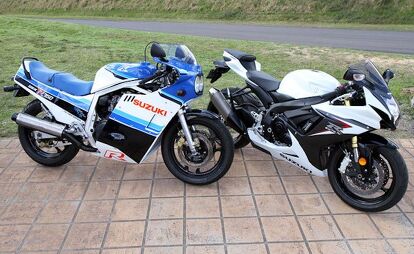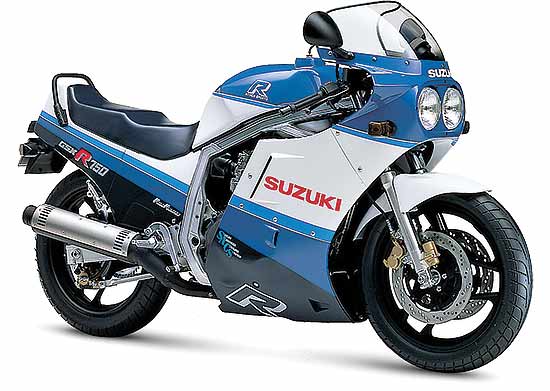Ask MO Anything: How Did We Finally Settle on 17-inch Wheels for Sportbikes Anyway?
Dear MOby,
And why did no one make me aware that tire choices for the 18-inch wheels on my new-to-me ‘87 Suzuki GSX-R750 were going to be severely limited? I guess it’s not a big deal, but it just got me curious how we went from 18s, 16s, 16.5 and 17-inch tires not so long ago – to almost nothing but 17-inch tires now on nearly every sportbike and sport tourer sold today? Why only 17-inch tires on sportbikes?
Curiously,
T. Rizz
Dear T.,
It’s an interesting question with a fairly simple answer, but first a short history lesson or why not a long one, since it’s a slow news day? The first “modern superbike” 1969 Honda CB750 had a 19-/18-inch front/rear tire combination, and the 1973 Kawasaki Z1 that usurped its title wore the exact same 3.25 x 19-in front and 4.00 x 18-in rear tires, on probably the same wire-spoked rims, and it was good.
By 1980, we were beginning to suspect we’d never be able to afford a Porsche 928, but might be able to someday aspire to a 1983 Suzuki GS1100E. OK, maybe a 550.
That GS was the new first “modern superbike” via its 16-valve Twin Swirl Combustion Chamber engine, but its 19- and 17-inch cast wheels were pretty high-tech too. Wikipedia says the ‘76 Yamaha RD400C was the first motorcycle by a major manufacturer to have cast wheels (18/18).
Enter the Radial
On the 25th anniversary of its first radial tires, in 2012, Michelin sent us this press release, which sums it up well:
Three years after first using it in racing, in 1984, Michelin decided to bring to market its radial motorcycle tire. In 1987, the MICHELIN A59X and M59X signaled the beginning of a revolutionary new era for high-performance tires that enabled riders to get the most out of the new motorcycles of the period.
In 1983, thanks to the genius of Freddie Spencer, Michelin won the first Grand Prix event on a 500 cc bike fitted with a radial tire (on the rear wheel only). The following year, Randy Mamola became the first rider to win a Grand Prix race (San Marino) on a motorcycle equipped with radial tires on both the front and rear wheels. A radial tire undergoes less heat build-up than a conventional tire. As a result, the rubber remains softer and delivers better grip when cornering.
Pirelli was right there too, building bespoke MP7 radials for the crazy, 150-mph European-spec 1984 Honda VF1000R– a 120/80-16 front and 140/80-17-inch rear.
Radial tires were here to stay by the time I got to California: The amazing 1988 FZR400 and FZR400R I cut my Rock Store teeth on rolled on 110/70-17 and 140/60-18 radials. The even more amazing FZR1000 a year later, and Suzuki’s new GSX-R1100, both got fat radial tires on wide 17-inch wheels. Meanwhile, contemporary sport-tourers like the GSX-F1100 Katana and Yamaha FJ1100 were a bit behind the times on 16-inch bias ply tires.
Your now highly collectible Honda RC30 threw the world an 18-inch rear curveball and a 17 front, and Mr. Baba decided to mix it up again with a 16-inch front tire on the world’s next first modern superbike, the 1992 CBR900RR.
Does anybody know the answer?
Basically, it was all in flux. The radial tire revolution opened the door for the power revolution and the chassis revolution, and all the engineers were busily trying to find what worked best while the appetite for sportier sportbikes just kept expanding. It was all a great excuse for the factories to go racing. Former Dunlop PR and Cycle magazine guy Ken Vreeke got this out of Eddie Lawson, who most famously won the 1988 500 GP championship on a Yamaha before doing the same on a Honda in 1989:
When Kenny and I went over in 1983, we tested both the 16 and 17 with the 500 GP bike. The bike wouldn’t turn on the 16 because it was wider. The 17 turned much better – the geometry on that bike worked with the 17. Later as the year went on, we only used 17s on the Yamaha.
When I went to Honda, they wanted me to try a 16. I knew I wouldn’t like it. But then I tested it and it worked great and we won races on the 16. Later on, the Honda geometry changed, and the 17 worked great. So I got to experiment with the two sizes, and really it was all about the bike’s geometry at that time.
Which makes perfect sense. Honda said the point of the 16-in front on the 900RR was to reduce weight and provide a bigger contact patch, but a lot of testers felt the RR was nervous in front and labeled the bike Experts Only.
What we learned anew since then is that more grip in front isn’t a good thing at all if it throws off the fine balance between front and rear. Serious roadracers routinely drift both ends of the bike, especially now with traction control, and no matter what size the tires are we’ve always known it’s critical to maintain that the rear will break loose before the front. We’ve also learned the value of the standard steering damper.
SPECS
And while Honda was battling Yamaha was battling Suzuki in that golden era of 500 GP racing, so was Michelin battling Bridgestone and, in America anyway, Dunlop. All the tire companies were looking for an advantage, too, which meant building tires to fit whatever wheels the customer was convinced were the winning hand that week – 16, 16.5, or 17 inches.
Neill Rampton, at Dunlop, was there:
“In GP and WSBK, the rims were not defined by regulation in the late ‘90s and early ‘00s. That’s how we got to R420 (16.5”). There were also many different rim widths used (even within the same team). I think with most series going to spec tires, everyone realized how much money they were wasting on carbon rims and the 17-in. regulation made sense. Especially for SBK, where the OEM fitments were all 17-in to begin with.”
Tire competition in World Superbike was the same, but on a slightly less grand scale and on production machines. For 2004, the decision was made to make WSBK a spec-tire series, with Pirelli stepping in to supply 16.5-in tires to all the teams.
Following the success of that experiment*, the tire wars also came to a Stylema-style halt in MotoGP when, in 2009, it too became a spec-tire series, with Bridgestone as sole supplier of 16.5-in rubber. That move both leveled the playing field – or at least gave riders one thing they couldn’t blame bad results on – and brought down costs in the aftermath of the previous economic crisis.
Four years later, in 2013, World Superbike made the switch from 16.5-inch to 17-inch Pirellis. The Italian tire behemoth is contracted to be WSBK’s tire supplier, for all classes, through 2023 – a 19-year run.
The final coup de grâce for any non-17-inch sportbike tire came in 2016, when Michelin took over from Bridgestone as MotoGP’s lone tire supplier, and proclaimed it would be 17-inchers for the lot of you going forward. Like Eddie said, you can make a 16 or a 16.5 or a 17 or 16.25 or a lot of other sizes work perfectly well once you adjust the motorcycle’s geometry to suit, but why spend all the money and effort to produce so many sizes, and have dealers stock them, etc., when 17 inches front and rear seems to have hit everybody’s happy place? Now all you’ve got to obsess about is the width. And air pressure. And compound. And?
——————————————-
* Pirelli put out a press release after that first WSBK season that read, in part: So what changed with Pirelli and the spec tire rule? Practically everything. Last year, a staggering 218 points separated the first three riders at season’s end (103 points between the two factory riders, 115 points between second and third place). This year, there were fewer than 100 points between the first five riders. Neil Hodgson won every race up to Laguna Seca last year, while this year’s championship was called “one of the most exciting and closely contested” in the 17-year history of the series. It came down to the final weekend.
Related reading:
Staying the Course: The FZR400 and FZR1000
Direct your motorcycle-related, personal, or really any questions to AskMoAnything@motorcycle.com, Remember, the only dumb question is the incriminating one you ask in public using your real name.
Become a Motorcycle.com insider. Get the latest motorcycle news first by subscribing to our newsletter here.
More by John Burns











































Comments
Join the conversation
Say, JB: No love for the short-lived "semi-radials"? :>)
As always, great writing Burnsie.
As I recall at the time 17s were the norm in MotoGP, but to give more mid-corner bump compliance they went to a 16.5 rim with the same overall diameter of the tire. This resulted in more sidewall for more compliance without having to redesign the chassis geometry.